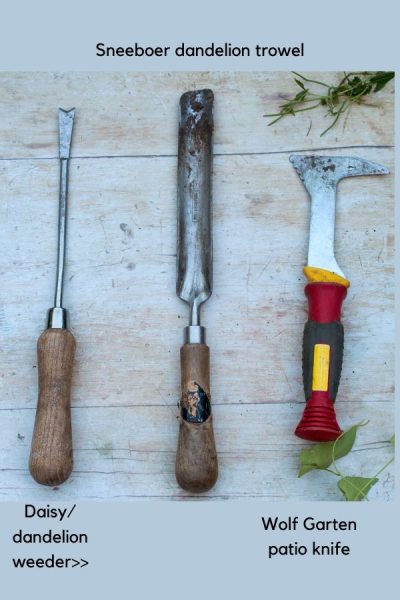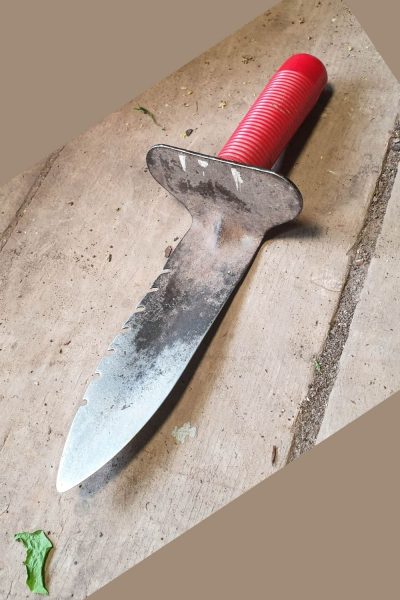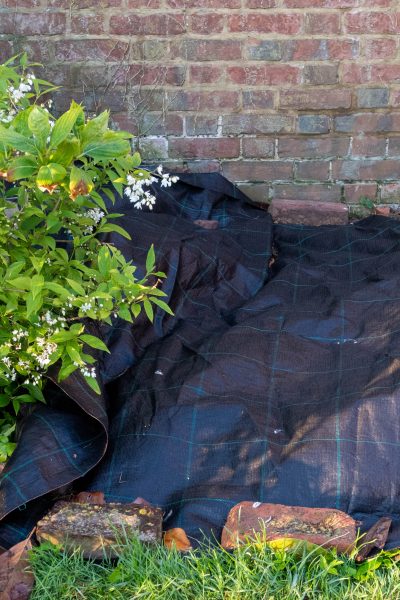[ad_1]
Would you like to find the easiest and best ways of weeding your garden?
I’ve been asking some of my fellow bloggers, garden experts and YouTubers for their best tips on keeping the garden free of weeds.
If you prefer watching a video to reading a post, see How To Weed Your Garden on the Middlesized Garden YouTube channel.
When is the best time to weed your garden?
No matter what you do to minimise weeding, it is still a year-round activity. But spring and early summer is the best time to get it under control because that is when the weeds are emerging.
Try weeding your garden thoroughly between March and June. After that, you’ll need to weed less.
But Laetitia Maklouf, gardening writer, is the author of The Five Minute Garden. She says that the way to fit gardening successfully into a busy life is to break down the tasks into small, manageable chunks.
Expert weeding tips from (from top) Nick Moyle of Two Thirsty Gardeners, Gardeners’ World presenter Mark Lane and garden writer, Laetitia Maklouf, author of the Five Minute Garden
So the Five Minute Garden breaks down those chunks with tips. When it comes to weeding, she says ‘try to do five minutes every single day.’ That is really excellent advice, because unless your garden is huge, you will really make a difference. Five minutes a day adds up to about 30-35 hours of weeding a year.
Many years before I had a garden of my own, I visited a grand open garden. I was with a friend who knew the owner so we were chatting to her when she suddenly bent down, mid conversation, and removed a weed from the border.

If you pick out a weed every time you see one, you’ll make a big difference to your garden.
I was impressed by this, because she had a team of professional gardeners. But she still got weeds, and when she saw one, she removed it immediately even if she was in the middle of doing something else.
I’ve always remembered that lesson – that you always need to be alert for weeds and you need to deal with them immediately. I just haven’t always acted on it.
The four basic ways of weeding your garden
There isn’t one way of weeding your garden. There are four basic ways, and I find it useful to use all four depending on the situation. Gardening World presenter and garden designer Mark Lane has summed these up for us much better than I could:
- Dig out weeds completely by hand, including the roots. If you leave even a scrap of root behind, it can re-grow.
- Cover weeds with a very thick mulch or black plastic. This deprives them of light so they can’t photosynthesise and eventually die off.
- Use weedkillers, either as a spray or a topical application, such as a gel.
- Hoe your weeds.
Mark has just started a YouTube channel called Mark Lane Designs. It has short, practical how-to videos on gardening, plus a weekly live Q&A on Saturday mornings (UK time).

Garden designer and Gardeners World presenter Mark Lane has just started his YouTube channel, with lots of practical advice.
The price of victory is eternal vigilance…
The first thing I ever learned about gardening, from a friend of mine who worked with the RHS, was probably the most useful. He told me to weed and mulch all round my garden before even thinking about what new plants to buy.
Do a small section at a time. Hand weed your plants and then cover the area with a layer of well rotted manure, garden compost, bark chippings or other mulch.
This deprives the weeds of light. It slows them down, so fewer re-grow. And when they do grow, they root in the nutritious mulch rather than in the soil. This can make them much easier to pull out when they reappear.
Because weeds will always reappear…
You can minimise weeds. You can get the most effective weeding tools (see below). But whether you spray everything with the most powerful chemicals or smother every inch of your garden in weed suppressing membrane, you will still get weeds back.
If you have researched ‘weeding’ on the Internet – as I have – you will find people saying that if you lay down horticultural membrane, then you’ll never have to weed again. Like every form of weed control, it does control weeds, very effectively.
But you usually cover it with gravel for paths or, say, bark mulch in border. Dust and weed seeds settle in that. Annual weeds are blown in by the wind and grow on top.
Weeds can also pop up around the sides of a light excluding mulch. And if you cut holes in it to plant, then weeds will grow out of the holes with the plants.

My weed-filled path. This has a weed suppressing membrane under it. Weed suppressing membranes suppress perennial weeds directly below them. However annual weeds soon settle on top. The perennial weeds’ roots will soon snake out under the edges of the membrane and set themselves up in an adjacent border.
Once you have accepted that weeds will always come back, then weeding becomes much easier. You’re no longer fighting a losing battle. You can work out a strategy that works for you. Think of weeding as being like brushing your hair.
You can choose an easy-care hair style, and get the best hairbrush for your hair. You can decide that you like the un-brushed look. But you will regularly – usually daily – have to brush your hair.
Although I must admit that my garden is often full of weeds and my hair could be tidier.
Weeding without chemicals
There are four ways to weed listed above. Three of them involve weeding without chemicals. If you don’t want to use chemicals in your garden, then stick to a combination of hand weeding, hoe-ing and a light-excluding mulch.
There are recipes on the internet for killing weeds with salt, vinegar or boiling water. They are all contact herbicides, which means they kill the leaves they touch. They don’t kill the roots. But they also kill any other leaves they touch, so it is difficult to use them in a crowded border.
If you re-apply often enough, the roots will die off. But wouldn’t it be less effort to hand-weed them out in the first place?
Salt, vinegar or boiling water?
Just because something is home-made, it doesn’t automatically mean it is safe.
Or that it is cheaper. The University of Maryland did a study on using vinegar as a household weed-killer. They worked out that, by the time you have killed the weeds properly with a vinegar solution, you would have spent more on vinegar than you would have done on commercial weed killer.
‘Agricultural vinegar’ is the most effective weed killer but it has 20{330f214df237fc2abc96aea099ffbe24c43e06db08036644267acddb2f21482d} acetic acid and can burn your skin or eyes badly. It should not be used by amateurs.
And salt leaches into the soil. It can damage the vital micro-organisms in the soil. You may have problems planting in that area.
As for boiling water – how do you keep a kettle boiling as you rush down the garden to that patch of bindweed at the bottom?
The best weeding tools
Garden designer Lee Burkhill of the Garden Ninja youtube channel thinks that the Japanese gardening knife or hori hori is the best tool. He’s also got a video on killing weeds with weed burner. You may like to consider it, as I haven’t covered weed burners here.

Garden designer, Lee Burkhill of the Garden Ninja YouTube channel.
I also use something similar – I think it’s known as a patio knife, and it’s a garden knife with a right angled tip, designed to scrape out weeds between patio pavers. Mine is the Wolf Garten Garden Scraper. I first discovered it when I saw a professional gardener use it for all kinds of weeding and since then I’ve used nothing else.

My weeding tools – a dandelion weeder from Spear & Jackson and a dandelion trowel from Sneeboer, as well as the Wolf Garten scraper.
For weeds with a deep tap root, such as dandelions, my husband uses something that looks like a very thin, long hand trowel. And, of course, you can always use a hand fork.

This is an American weeding knife, and it belongs to Tom Coward, head gardener at Gravetye Manor Hotel. It’s very similar to a hori-hori.
Use a light excluding mulch
The second method Mark Lane mentions is to cover your border completely with black horticultural plastic or similar (many people use cardboard, which slowly decomposes into compost. It’s a good way of getting rid of a whole bed of perennial weeds.
So I asked organic gardener Charles Dowding of the Charles Dowding Youtube channel about this.
Charles advises starting in February while the weeds are still dormant. ‘It will take about three to four months to kill off creeping buttercup in this way, but couch grass will take until around August. And bindweed can survive under light-excluding matting for a couple of years.
As you won’t want to cover your border for two years, Charles suggests covering it for one season ‘to weaken the bindweed.’ Then follow up with regular hand weeding – you need to do it every week.

I’m clearing a patch of ground elder by leaving it covered with horticultural membrane for a summer. I have to check around the edges regularly and also weight it down well.
You will need to weigh down the black plastic as I have found that the wind whips it off quite easily.
And check around the edges. Many perennial weeds have incredibly long roots – this is just one piece of bindweed I got out from a border, so you can see how a root could easily survive on an adjacent border and sneak back.

All this is just one strand of bindweed which I weeded out of my garden yesterday. Those roots can travel!
There are also living mulches that break down over time to feed the soil, such as bark mulch, chipped wood and straw mulch. I’m trying out a layer of straw mulch (Strulch) on my veg borders at the moment.
The idea is that it deprives annual weed seeds of light. It’s been on for around 5 weeks, and it has certainly slowed down the growth of weeds, but it hasn’t stopped them.
It’s not a substitute for regular hand weeding – it just means that every session of regular hand weeding can be done quite quickly. There are fewer weeds and those which do grow come out really easily.
If you do want to use chemical based weed killers
Mark also mentions chemical sprays. He recommends a spot treatment on plants rather than sprays.
I agree completely because I have found it impossible to protect the plants adjacent to weeds when using a spray.
I cover them with plastic or I cover the weeds with a plastic bag and spray inside that and I only spray on wind free days, but the weedkiller spray always always affects the plants beside it.
However, it’s also worth pointing out that dabbing a spot of weed killer on each leaf is as time consuming as weeding by hand.
How to hoe
And then there’s hoeing. I asked Charles Dowding how to hoe. He says you need to start hoeing as soon as you see the tiniest shimmer of green: ‘There’s a saying that you need to start hoeing your weeds before you can see them.’
Just tickle the surface of the earth – the top few inches – with the hoe, chopping off the heads of any annual weeds. He just leaves the weed heads on the earth.

Charles Dowding of the Charles Dowding YouTube channel and author of many books including Organic Gardening, The Natural No Dig Way. I talked to Charles to find out how no-dig/no till works for flower gardens.
Hoe-ing is not a heavy activity. It’s particularly suitable for plants in rows, such as vegetables. And you can cover a lot of area in a short time.
Charles uses an oscillating hoe. I have just ordered one (not the same brand as Charles’).
Other ways of making weeding easier
As well as using good tools, there are other ways of making weeding a bit easier.
Disposing of weeds adds to the work.
Alex Mitchell, gardening journalist and author of Crops in Tight Spots, on growing vegetables in small spaces, says she ‘just turns annual weeds into the soil so they rot down, as long as they haven’t flowered,’ she says. She also lets perennial weeds die completely then adds them to her compost heap.

Crops in Tight Spots by Alex Mitchell
Liz Zorab of the YouTube channel Liz Zorab -Byther Farm is a ‘homesteader’ (someone who aims for a self-sufficient lifestyle). She only only weeds where she needs to – which is the vegetable bed. Vegetables really hate the competition from weeds.
So if your weeding time is limited, start with the veg patch.
Weeding your garden with the help of friends and family
And then there’s getting help.
Blue Peter presenter and Skinny Jean Gardener podcaster, Lee Connelly, author of How to Get Kids Gardening, says that children will enjoy helping you weed if you make it a competition – ‘see who can fill the biggest bucket.’

Skinny Jean Gardener, Lee Connelly and his book, How to Get Kids Gardening. The book has lots of tips and tricks to help you encourage your children into gardening. It makes gardening a fun activity for the family, and could give them a lifelong love of it.
There’s always the issue of whether children or other helpers can tell the difference between weeds and plants you want to keep, in which case here’s an easy trick. Mr Middlesize weeds our paths and terrace, but has no intention of learning anything about either plants or weeds. So I tell him that if there’s a plant growing on the path, it shouldn’t be there, so it’s a weed.
‘De-classifying weeds…’
You can also cut down on weeding your garden by cutting down on the number of plants you consider weeds. Many weeds are effectively wild flowers. They are hugely important for wildlife, especially pollinators.
So there’s a trend towards tolerating or encouraging plants that would have been yanked out as weeds just a few years ago.
As Jack Wallington, garden designer and author of Wild About Weeds, says ‘Re-assess the weeds in your garden and see if you can even find one you’re happy to tolerate, because not having to weed it out will make your gardening easier and more pleasurable.’
Wild About Weeds will help you work out which weeds to keep and which to weed out.

These Spanish bluebells are considered weeds by some people because they are very invasive. On the left hand side of the dog is a creeping buttercup, which definitely is an invasive weed. I can tolerate the bluebells, though I do pull quite a few up every year. The creeping buttercup has to go.
Turn your weeds into tea…
Weeds have their uses. Some gardeners even make tea with their weeds.
Nick Moyle of the Two Thirsty Gardeners blog has a new book out called Wild Tea. It has recipes for making teas from several weeds – nettles and dandelions, as well as from a range of garden plants, such as rhubarb, thyme, bay, borage or rose.
Nick says “I always see if there’s a good reason for declassifying a plant as a ‘weed’ in my garden before despatching it. Can I eat it? Can it be turned into a drink? Does it look nice? Does the wildlife appreciate its presence? Once I’ve gone through that assessment I’m not left with much, apart from bindweed and couch grass – and for that I have no tips, other than a long, labour intensive battle.”
Change your weeding mindset…
Perhaps one of the best ways of weeding your garden is to change your mindset.
My daughter has been living with us, working from home, over lockdown. At the end of the day, she does fifteen minutes weeding because it gives her eyes a rest from the computer screen and she enjoys the fresh air.
Recent research has shown that turning the earth while weeding releases microbes into the air. When you inhale them, your serotonin levels rise and you feel more relaxed.
So perhaps it’s time to consider weeding your garden as therapy for you, not just for your garden.
Pin to remember weeding your garden
And do join us every Sunday morning for tips, ideas and inspiration for your garden.

[ad_2]
Source link
